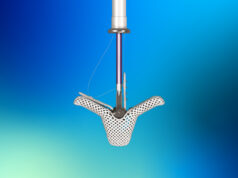
A novel risk score derived from artificial intelligence (AI) may be more effective than currently used models at predicting one-year survival prognosis and identifying individuals at extreme risk of mortality or lack of clinical improvement among patients with secondary mitral regurgitation (SMR) undergoing transcatheter edge-to-edge repair (TEER).
Lukas Stolz (Klinikum der Universität München, Munich, Germany) detailed the design and validation of the EuroSMR score during a late-breaking trials session at PCR London Valves (19–21 November, London, UK).
“We have learned from the COAPT and MITRA-FR trials that patient selection and risk stratification prior to mitral TEER is key in order to optimise outcomes after the procedure,” Stolz commented. Existing risk scores have largely been validated against patients undergoing surgery, he explained, and have other limitations including having been derived from relatively small datasets or lacking independent validation.
Stolz and colleagues used data from 4,600 patients from the European registry of transcatheter repair for secondary mitral regurgitation—EuroSMR—to develop their risk score, seeking to predict a patient’s mortality and freedom from New York Heart Association (NYHA) heart failure class III or IV at one year.
The researchers fed an AI model with 28 relevant clinical, echocardiographic, laboratory and medication parameters, and the algorithm identified the 18 parameters which had the strongest contribution to an optimised risk prediction of one-year mortality.
“We can find some typical predictors in the field of valvular heart disease, for example symptomatic status of our patients, right ventricular dysfunction, left ventricular dysfunction, renal dysfunction, we have comorbidities like diabetes, but also guideline-directed medical therapy (GDMT) plays an important role,” said Stolz of the parameters that were found to make the greatest contribution to risk prediction.
Detailing the validation of the risk prediction model, Stolz commented that the score “differentiates well” between surviving and dying patients. “What we can also see is that the surviving Kaplan-Meier charts of the derivation of the validation cohorts were more or less superimposed, which means the score does not only work in the derivation cohort but also in the validation cohort,” he said. The model outperformed existing risk scores such as Euroscore II, the MITRA Score and the COAPT Score, Stolz added, achieving an area under the curve (AUC) of 0.789.
“The AI derived EuroSMR risk score is a novel and improved risk calculator, not only for prediction of one-year mortality, but also one-year mortality free from heart failure symptoms,” Stolz said in the conclusion to his presentation. “The EuroSMR score might not only facilitate talking to your patient and finding the right therapy, but it could possibly be an important aid for the heart team to take a decision.”










